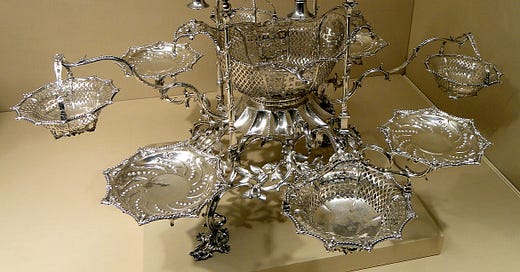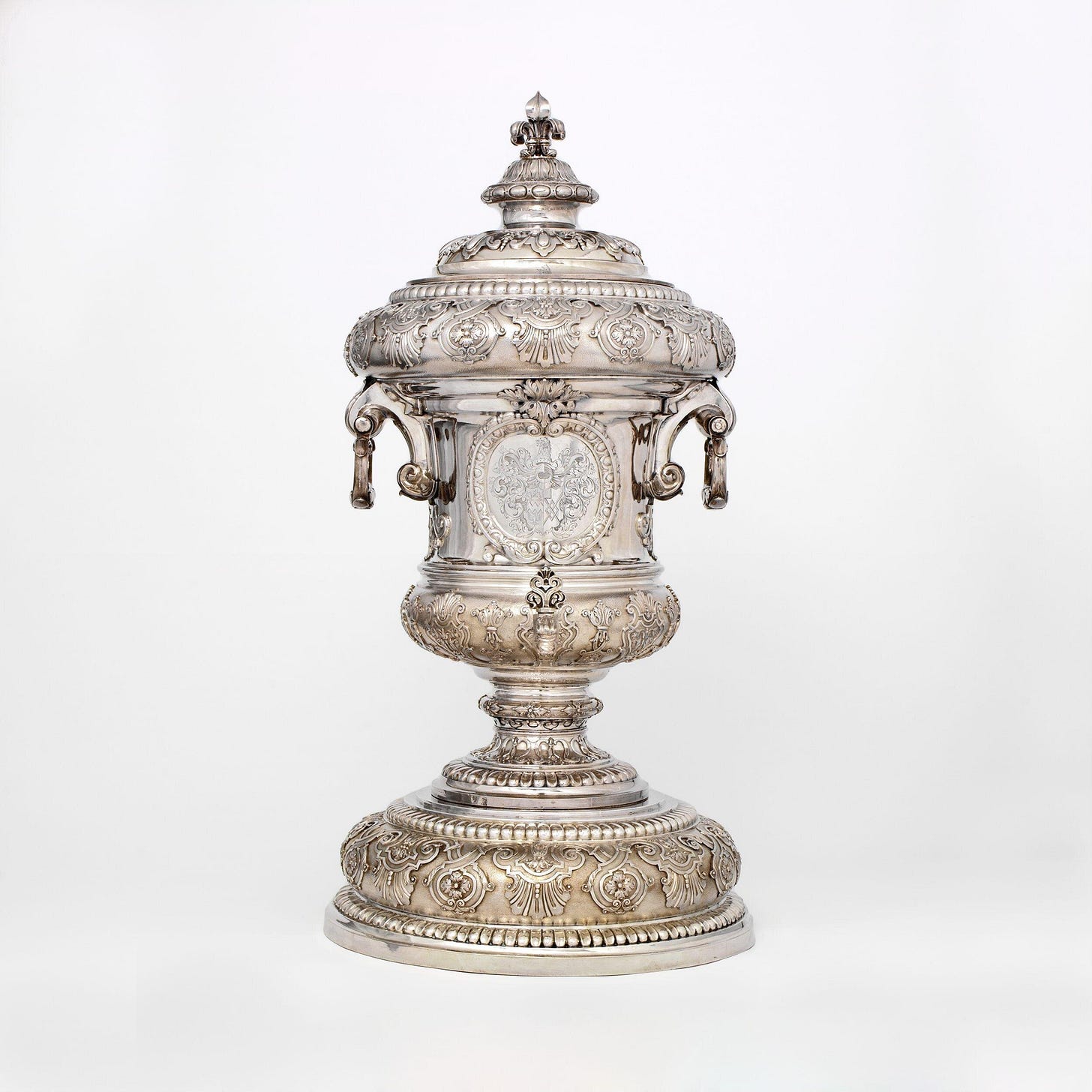As described in my last post, I went to visit Highclere House last week, aka Downton Abbey. Rather than being owned by the National Trust, it’s still in the hands of the current Earl and Countess of Carnarvon, which means that the ‘visitor experience’ is different in places. This is not just because someone in the National Trust will decide that scenes of Imperial conquest are perhaps not the best thing to have on display in the bedroom corridor.
Downstairs, Highclere also displays something which the vast majority of stately homes have lost, a collection of silver plate. These days, the plate sits in a high security cabinet set into an alcove in the servants corridor, so this is literally a niche subject. And one, once again, that I was not allowed to take a picture of. But bear with me, it’s worth your time.
There’s a fantastic range of stuff in the niche, from salvers to candle snuffers and fruit scissors. This family silver used to be one of the chief display items for every aristocratic house. Any self-respecting dinner party would involve setting out large quantities of visible wealth on the dining table, in the form of everything from platters and tureens to candlesticks, cutlery and strange centrepieces which held fruit and flowers and were mainly designed to use the maximum metal and craftsmanship possible in a confined space.
It’s kind of medieval to impress people by stacking all your wealth on the table and dressers, but the upper classes have always embraced being old-fashioned. And silver has another advantage too, it’s portable wealth, which means that it can always be converted into cash when times are hard. Hence the cliche of ‘selling the family silver’.
Which is why, if you go to the V&A silver galleries, you will find a whole collection of eighteenth and nineteenth century pieces of silverware engraved with the arms of aristocratic families. Although the museum is mostly interested in makers and design, and very much downplays these marks of ownership to the small print on the labels.
This is a wine fountain (yes, really) with the arms of Sir John Walter of Sarsden Oxfordshire was Clerk of the Green Cloth in the Royal Household and Member of Parliament for Oxford. Many much grander families are represented in the collections, and there is silver from Blenheim, Althorp and Kedleston in the cases too.
So the silver is not just shouting about wealth, it’s also doing the more conventional aristocratic demonstration of how long their bloodline has been in one place (the subtext being that we have ruled for so long that it is an immutable truth of nature that we are meant to rule so we’ll carry on).
But silver is also doing another form of display which is less visible to us now, and that’s a demonstration of labour. Back then, it was meant to shine with an almost bluish tinge (which you will note it is not doing in any of the photos above). This was achieved with jewellers rouge - finely ground iron oxide - and ammonia. And a lot of pain. The caustic ammonia had to be applied with bare hands to get the right finish. The footmen and butlers would blister their fingers over and over again until the skin hardened, resulting in ‘plate hands’, shiny, red and as solid as boards, and allegedly a badge of honour for any good footman or butler.
I was just told to get on with it. The blisters burst and eventually you developed a pair of plate hands that… became as hard as boards.’
But these did not look as impressive to their employers. One of the reasons why footmen and butlers would wear white gloves when they were serving was to hide these scars. Or, to put it differently, so that the upper classes didn’t have to see the results of their exploitation. That might just spoil the dinner.
We’re in a complicated dance here between what is seen and what is not seen, what is displayed and what remains hidden. The vast majority of houses no longer have their silver, so what we are walking through is only a part of how they were set out in the eighteenth and nineteenth century. Nothing is authentic about the presentation, it’s a partial and modern creation. Where houses do have it on display, the labour of the servants remains, as always, invisible. Meanwhile in museums, the salvers and the basins are extracted out of all context of wealth, place, inheritance or ownership - the things that mattered so much when they were made - and seen only as an act of design and creation, by a craftsman. As ever, the question seems to be, “What exactly are we looking at here?”
Which does of course lead inevitably on to, and who decided it was so? And why? Answers on a postcard please.
And for those of you who think I am being a bit harsh here, you can cleanse your palate with Lady Carnarvon’s blog about how lovely the silver is at Highclere. For fans of Private Eye, this includes the phrase “one of the most famous English spoon sets”.







As the great-great-granddaughter of a footmen, later butler, this fascinates me. I'll be sharing it with my mum, with whom I'm currently involved in writing a family history, thank you.